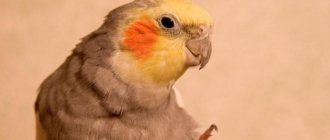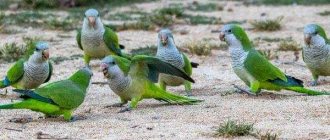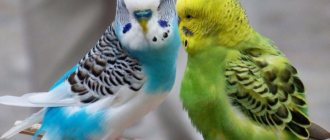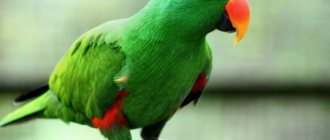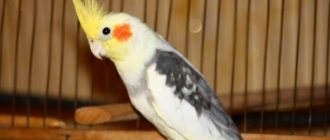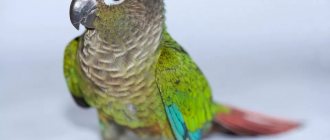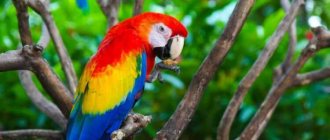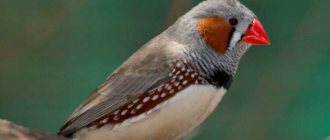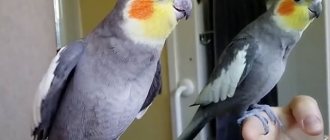Today, the Corella parrot ranks after the budgerigar on the list of recognizable exotic birds. Nymph parrots, as they are also called, can change until the first year, only after this stage you will see how the appearance of the pets changes. And according to reviews from the owners: it is impossible to know everything about cockatiels! After all, they are funny, funny and dancing favorites, with whom it is never boring to sing!
Appearance
In appearance, the nymph parrot belongs to the subgroup of flat-tailed birds. The rounded beak is very active and large, unlike other representatives of birds. The four-toed paws are usually directed in different directions. This natural characteristic is required for dexterous movement along tree branches and convenient capture of food. A special feature is the elongated shape of the plumage on the back of the head.
Monk (Kalita) – European pigeon
This fairly popular variety of pets in Spanish, Brazilian and other cities is considered a street pet and is comparable to Russian pigeons. These birds began to be called monks because of the similarity of the colors of their plumage with the cassock. The crown, back and tail are bright green or turquoise, and the front of the face and body are pale brown.
But the character of these talking birds is not at all monastic. They are characterized by:
- playfulness;
- curiosity;
- impudence.
These parrots are easy to tame. They are not particularly talkative. Vocabulary – several dozen words. The voice is hoarse, as they say, not for everybody.
Color variations
By the tone and color of the plumage, you can distinguish the subspecies of cockatiels and their gender. Corella girls are lighter than male parrots, with the exception of cockatiels - albino. There are designs ranging from silver to dark gray and black varieties, but this depends on the purebred of the subjects.
Crossbreeding affects the nature of the color that appears due to the mixing of genes. The permanent attribute is a light yellow crest with bright orange cheeks. Up to a year old, newborn chicks will have dull bodies like adult females, but as they mature, they will become brighter and have more pronounced colors. In most cases, nymphs have pink nostrils.
The main color variations of the Cockatiel are the following colors: white, dark yellowish, light gray, pearl. Based on this, there are varieties with corresponding breed names.
White
Sea green cockatiels are not albino and get their nickname from males who carry the specific gene, although they are actually a shade of grey. They are crossed with purebred females, which allows the gene to unfold unhindered. One of the subtle differences between males and females is their black pupils. A remarkable bright yellow coating has been seen in both sexes - females and males, but that's where the similarities end. You can distinguish them by their tails:
- The male parrot is purely light colored with two long white feathers.
- In the female, where the undertail is, there is an impression of a clear marbled tint, although the color itself is yellow.
Dark yellowish
This bred subspecies of birds (dark yellow Corella parrot) appeared from mixing a variety of cinnamon colored birds. Coloring varies from dark amber to light vanilla. The lightened areas and the appearance of color are directly related to the gray cover.
Light gray
The light gray cockatiel boasts smoky feathers all over its body except for its milky wings, sunny face and bright orange cheek patches. Both sexes, female and male, have wide pale stripes along the edge of each wing.
Females and males of Corellas are light gray in color (until the 1st moult) and are covered with a dull orange pigment; their faces are not bright yellow, but more gray with an admixture of yellowish coloring. The tail parts of parrots contain a whitish or yellowish line on the underside.
Corella lutino
Definitely one of the cutest parrots is the lutino-colored cockatiel. They are often confused with the wavy family, but are distinguished by the bright scarlet cheek patches on both individuals. At birth, their eyes are reddish in color, but over the years it turns into a softer burgundy-cherry tone. The beautiful color of the plumage also has its drawbacks; under the tail and crest there are bald spots.
Albino Corella
With a complete lack of spots and uniform color, it would be a mistake to call an albino Cockatiel completely white, because some individuals were found to have a slight creamy (vanilla) coating. However, due to its characteristic lack of pigment, it has earned its name.
- Firstly, the crest and the upper area of the head and face have yellow down, which appears after molting.
- Secondly, the female has a light golden mixture on the wings and undertail.
Girls and boys are very similar, because their red-cheeked head looks the same. But they can be distinguished by different degrees of whiteness of the body; males are definitely whiter. To distinguish their tone from another subspecies, it is enough to pay attention to the coat (pale) and eyes (red). They are jokingly called cheekless.
Corella Sheki
Their peculiarity lies in the idea that there are white spots on the cover. It looks aesthetically pleasing and attracts public attention. The most valuable representative of the Corella is Sheki, whose color is symmetrical while maintaining equal proportions of the main shade and snow-white color.
Pearl
The pearly cockatiel has the same colors as a shell with pearls only on the edge of its wings. The bird is a transparent yellowish or beige tone, with solid colored patches on the rest of the body. Males have yellow faces with golden cheek patches. The term "pearly" refers to the lacing or patches of lemon, pearl, or white on the back, nape, and wings.
The pearl parrot nymph is also often called a "lacewing". Female cockatiels, unlike male cockatiels, retain their pearly coloration into adulthood, at a time when males lose their pearls after their first molt (becoming a pied alpha, rather than remaining pearlescent).
Whiteface
During crossbreeding, the white-faced cockatiel lost its orange and straw colors. The head of the female is gray. The tail feathers of the weaker sex have a white wavy pattern. Males are different in appearance, they lose the usual mask and dark gray body color of the main plumage.
Cinnamon colored cockatiel
The Cockatiel cross that produces the cinnamon color is similar to the normal one with the gray areas replaced by brown or shades of brown. The cinnamon cockatiel gets its name from the color it represents, which has been described as a brownish-gray coloring.
Unusual noses
The most numerous genus, like the family itself, is called cockatoo. It includes the following types:
- big-nosed,
- slender-billed,
- bare-eyed,
- Goffin's cockatoo,
- Solomonsky,
- Philippine,
- small and large yellow-crested,
- spectacled,
- great white-crested,
- Moluccan - a genus of cockatoo
A wide but short crest distinguishes the nosed cockatoo. A white bird with red spots on the throat and a stripe on the forehead weighs approximately 600 g. Together with the tail, the length of the body is 52 cm. The name of the species comes from the characteristics of the beak, the length of which is greater than the height.
The slender-billed cockatoo is also called the Western Nosed Cockatoo. It has a short crest, white color, but the bases of the feathers on the chest, back and head are pink-orange. Body dimensions up to 40 cm. The naked-eyed cockatoo is similar to it, but representatives of this species do not have feathers growing around the eyes, and the skin color in this place is blue.
Intelligence and character
All types of cockatiels are recognizable due to their unpretentious and friendly personality. Birds get along easily with humans and are smart conversationalists. It is not their behavior to be aggressive towards people or their own kind. They quickly learn individual words and phrases and are able to remember melodies (the opposite of a lovebird).
The optimal vocabulary of a cockatiel is 200-300 words. Like any animals and birds, cockatiels can be trained using the gingerbread method. They reproduce with detailed accuracy the sounds of household noise, such as opening a door, a doorbell, or a telephone. In this they are similar to their closest cousins, the cockatoo, the rosella or the Indian necklace.
In order to teach a Corella to speak, you need to buy a chick in childhood and it is best that it is immediately accustomed to being handled. They remember well the sounds with which they associate a certain room, time or action. If you tell your pet a story, the cockatiel will forget it the next day.
For example, the phrase “Good morning” is said only before feeding. If you repeat it repeatedly throughout the day, she will simply say it mindlessly. For every attempt, even if it’s not clear, reward him with a treat or a pat on the neck.
The Corella parrot remembers its name faster with the accompaniment of voicing actions (Kuku eats, Kukku goes to bed, etc.). Parrots are very affectionate towards their owners and treat them as members of the flock. Males, as a rule, are more active than females, whistle and their chirps are more melodious. Breeding requires extreme caution and attentiveness on the part of the owners. If the very nature of pets is kind to humans, this does not mean docile behavior when there are a large number of birds in a confined space.
Budgerigar
This talking feathered baby is in great demand as a pet. The budgerigar leads the most common and popular species of pet parrots.
Australian in origin, budgerigars have a very attractive appearance. They are small in size - only 16–23 cm. At the same time, the weight is a maximum of 50 g.
The birds have bright colors. Mostly there are individuals with plumage of the following colors:
- green or herbal;
- yellow;
- blue or blue;
- white;
- black or dark gray.
Combinations of these colors, both symmetrical and chaotic, are not uncommon. In addition to the colors listed, through the efforts of breeders, an anthracite parrot was bred. Individuals with plumage of this color are quite rare. In addition, the pink and purple budgies are considered rare.
Regardless of the main color tone, black wavy lines are painted on the feathers that cover the wings, head and back, as if with an artist’s brush - this detail of the color of the plumage determined the appearance of the name of this species of parrots.
These small pet parrots are highly intelligent. They are easy to train and are able to imitate human speech. In addition, birds of this species are characterized by:
- friendliness;
- playfulness;
- curiosity;
- sociability;
- unpretentiousness in care;
- low feed consumption.
Despite their talkative nature, these pets do not make as much noise as you might expect.
The average lifespan of birds is 10–15 years, but with special care, a pet can live twice as long as the average.
Spreading
Australia is named as the birthplace of the nymph breed. They live in grassy areas with trees and shrubs spaced apart from each other. Parrots were found on plains along river banks and semi-deserts. They like to move in small groups of 20-50 birds, if not during the breeding season. In regions of severe drought, they accumulate in large flocks near water bodies at a safe distance.
Despite free breeding in captivity and easy adaptation to the human environment, Australian legislation prohibits the export of the Corella breed outside the country. However, there are also tame parrots; they adapt well to an unusual place and, under proper conditions, live from 15 to 25 years.
Where does the cockatiel live in the wild?
The natural range of nymphs is the central part of Australia. They are rarely found near the ocean; they are suitable for spacious plateaus, grassy plains, and thickets of bushes near rivers. Parrots of this species prefer to breed in tree hollows, and when the chicks grow up, the flock flies from place to place. Nomadic life is important during dry periods, as food and water become increasingly scarce. In a community, it is easier for birds to find food and escape from predators.
Lifestyle
Mostly Corella parrots live in areas such as forests and eucalyptus groves, which are located along the banks of rivers, and in savannas with overgrown grounded bushes. In the wild, they are not used to hiding in the crowns of trees, sitting on the tops. They show different attitudes towards people, depending on where they are: they are afraid in the grass, but in the atmosphere they are used to (at the tops of trees) they are more docile. The birds' habits are more family-like and calm.
Outside their territory, parrots are very careful and circumspect. They do not stay on the banks of reservoirs and rivers longer than expected; to satisfy their thirst, they descend vertically to clean water, after drinking, they return home. Birds' favorite food is the seeds of herbaceous and woody plants, sometimes wheat seeds.
Drowsiness in males and females occurs both at night and during the day. Interesting facts about their regime are explained by the hot climate, where food is most likely obtained more easily at dawn and in the evening. They do not sleep soundly, and despite the small ears of the parrot, they hear the most insignificant rustles. The male sleeps less than the female due to protection of the offspring. Because of this, the male's beak is much stronger.
Confusing classification
Black-billed, white-billed and nymph-billed are subfamilies of the famous crested parrots. They include several genera and species that differ in size, habits and appearance. Let's highlight the brightest representatives of cockatoos:
- black,
- mourning,
- helmet-bearing,
- pink,
- Inca cockatoo,
- corella (nymph).
History says that the classification of birds was initially confused by scientists themselves. It started in 1760. Each ornithologist who took up the task unraveled the work of the previous one. Often the studies were based on amateur drawings, which led to confusion. The lack of biomaterial led to disputes that lasted more than two centuries.
By 2012, 7 genera had emerged. The position of the cockatiel remains unclear, regarding which opinions are still divided. Some ornithologists take it outside the family.
Care
Keeping an eye on Cockatiels at home is not as easy as it seems. First of all, to keep parrots, you need to buy a cage. It must be roomy so that the parrot can move freely around the house from anywhere. The smallest cell parameters correspond to 65 centimeters in height and 50 centimeters in width. The perimeter is approximately no less than one meter.
Choose a house made of pure stainless material. To make cleaning easier, the bottom should be spread over the pull-out tray. Place two or three wooden posts inside the cage, but do not place them above the feeders. If branches from the yard are being used as posts, be sure to run boiling water over them to maintain sanitation.
Caring for cockatiels will require daily cleaning of the tray. It is also necessary to carry out general cleaning once a week: thoroughly wash the cage and everything in it. Place it in a bright room at eye level so that the pet will soon get used to family members. Do not place in drafts or direct sunlight, especially during hot weather suitable for your area.
Feeding
The basis, of course, is a grain mixture, which should indicate that it is suitable for a given type of parrot. Additionally, you can germinate grains, give porridges that are cooked in water without salt, oil and spices (oats, wheat, buckwheat, rice).
Be sure to include vegetables and fruits (carrots, cucumber, zucchini, broccoli, banana, apples, citrus fruits). In the summer, it is good to treat the bird with berries. You can also leave branches of fruit trees, willow, linden, and birch. They need to be thoroughly treated with boiling water and soaked in water.
Don't forget about the mineral stone, sepia.
Reproduction and breeding
Nature creates the entire environment for the life of the inhabitants of the planet Corellas. Therefore, each male is given the opportunity to feed and reproduce without obstacles. Such conditions occur during the rainy season, when food supply increases for all members of the bird group.
The nest, which is located in hollow branches and trunks of already withered trees, contains approximately 3 to 7 Corella eggs, preferably whitish-colored shells. They incubate the eggs for 3 weeks (21 days), in which neither one, but both parents participate. Chicks are born with yellow fluff. Getting ready to release the cubs after a month or a month and a half, the parents begin to hatch the next offspring.
In a family setting, breeding nymph parrots is not easy, but feasible. It is not enough to prepare the entire external environment; you need to set the birds up for a close relationship and choice of partners, without aggression (for beginners, this means combining the cage and observing behavior). After this, you can see the stage of pregnancy and how the female parrot laid a clutch of eggs. How many eggs there will be depends on favorable conditions.
Please note that, for example, lutino parrots love to fly to maintain a healthy shape. Therefore, free him from his house so that the bird can fly. If it is not possible to release it, a large cage is purchased so that the bird can fly right in it. When releasing the parrot, do not forget to close the windows, and at this hour it is also worth prohibiting access to dogs and cats.
Song breed of Rosella parrots
The cute Australian rosella parakeet does not speak, but sings – melodiously and pleasantly. The bird's voice is beautiful, expressive, and his manner of performance is calm. By nature, Rosellas are calm and friendly. But they will not be able to get along in the same cage with a bird of a different species - the sharing will end in a fight.
Rosella has average dimensions - 20–30 cm. The colors of the plumage are varied. Most individuals can be divided into two categories - those with a pale yellow head or those with a red head.
Development schedule
If you want to have an idea of how much a cockatiel chick should weigh at different stages of its development, you can check out the following table:
Don't worry if your chick develops slightly differently than described above. After all, each bird is individual, with its own characteristics.
Some kids may be a little behind the generally accepted parameters, while others may, on the contrary, be ahead of their brothers. The main thing is that the parrot is healthy, active and not sick.
How much does your parrot weigh?
If you liked the article, please share it with your friends and like it.
Tags: Cockatoo
ptitsadoma.ru
How to tame?
The question of how to tame a cockatiel involves several steps: let the bird get comfortable in a new place, talk to it, offer a treat from your hands so that the parrot, on its own initiative, approaches and takes it, gradually complicating the task so that the bird has to stand on your hand to access delicacy. This simple and effective technique always works. The main mistake that hinders taming is the impatience of the owner, who wants to get quick results.
We also recommend that you read the material “How to tame a parrot.”
Do cockatiels talk? This is a question that often arises during the learning process. The answer is yes, they can teach you to reproduce human speech, although their abilities are quite limited. In addition, not all of them can learn to speak at all. At the same time, these parrots are able to remember and imitate various sounds and melodies quite well.
History of the discovery of the species[edit | edit code]
Budgerigars were first described in 1805 by the English naturalist George Shaw in his work “Naturists Miscellany” (1781 - 1813)[4]. At the same time, his colleague, artist G. Nodder, made the first drawing of this bird. In 1831, visitors to the Carl Linnaeus Society Museum saw a stuffed specimen of this exotic creature for the first time. When Australia began to be settled by convicts, they began to domesticate birds and keep them in cages.
An employee of the Museum of the Zoological Society of London, ornithologist John Gould, in 1837, in the book “Handbook of birds of Australia”, first described the life of budgerigars in nature so well that later observations did not add anything significant to the present day [5]. He is the first to describe a budgerigar in the wild. The great ornithologist created a 36-volume work “Birds of Australia”, in which he mentioned this species of parrots. In 1840, budgerigars were first introduced to London Zoo. It is believed that they were brought from Australia by Gould.
Budgerigars were delivered from Australia by sea, and a large number of birds died, unable to withstand a long (more than 2 months) voyage. As a result, the Australian government was forced to pass a law banning the export of any birds living in the country. It is currently prohibited by law to export any species of fauna from Australia except those born in captivity.
grass parrot
Small parrots of Australian origin with dimensions of 20–25 cm in nature make low and short flights, so the cage for them should not be high, but long. The color options are varied, but mostly of a camouflage nature.
The bird's voice is melodious. The parrot only sings, does not talk. Life expectancy rarely exceeds 20 years.
